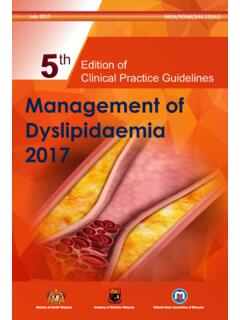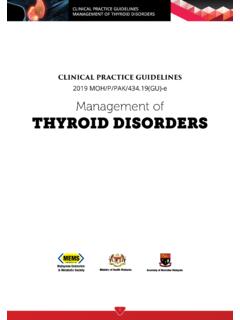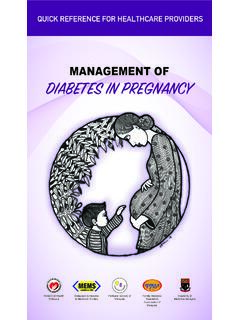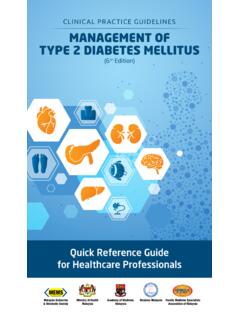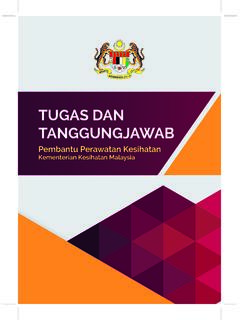Transcription of MANAGEMENT OF TUBERCULOSIS
1 1 CLINICAL PRACTICE GUIDELINES 2021 MOH/P/PAK/xxxxxx MANAGEMENT OF TUBERCULOSIS (FOURTH EDITION) Ministry of Health Malaysia Academy of Medicine Malaysia 2 Published by: Malaysian Health Technology Assessment Section (MaHTAS) Medical Development Division, Ministry of Health Malaysia Level 4, Block E1, Precinct 1 Federal Government Administrative Centre 62590 Putrajaya, Malaysia Copyright The copyright owner of this publication is MaHTAS. Content may be reproduced in any number of copies and in any format or medium provided that a copyright acknowledgement to MaHTAS is included and the content is not changed, not sold, nor used to promote or endorse any product or service, and not used in an inappropriate or misleading context. ISBN: Available on the following websites: Also available as an app for Android and IOS platform: MyMaHTAS STATEMENT OF INTENT These clinical practice guidelines (CPG) are meant to be guides for clinical practice, based on the best available evidence at the time of development.
2 Adherence to these guidelines may not necessarily guarantee the best outcome in every case. Every healthcare provider is responsible for the MANAGEMENT of his/her unique patient based on the clinical picture presented by the patient and the MANAGEMENT options available locally. UPDATING THE CPG These guidelines were issued in 2021 and will be reviewed in a minimum period of four years (2025) or sooner if new evidence becomes available. When it is due for updating, the Chairperson of the CPG or national Advisor of the related specialty will be informed about it. A discussion will be done on the need for a revision including the scope of the revised CPG. A multidisciplinary team will be formed, and the latest systematic review methodology used by MaHTAS will be employed. Every care is taken to ensure that this publication is correct in every detail at the time of publication.
3 However, in the event of errors or omissions, corrections will be published in the web version of this document, which will be the definitive version at all time. This version can be found on the websites mentioned above. 3 TABLE OF CONTENTS No. Title Page Levels of Evidence and Formulation of Recommendation i Key Recommendations ii Guidelines Development and Objectives iv Development Group vi Review Committee vii External Reviewers viii Algorithm 1: MANAGEMENT of Active TUBERCULOSIS ix Algorithm 2: MANAGEMENT of Latent TUBERCULOSIS Infection x 1. INTRODUCTION 1 2. SECTION I: ACTIVE TUBERCULOSIS 1 Smear Positive Pulmonary TUBERCULOSIS 1 Smear Negative Pulmonary TUBERCULOSIS 6 Extrapulmonary TUBERCULOSIS 8 Recurrent TUBERCULOSIS 13 TUBERCULOSIS in Special Situations 14 Human Immunodeficiency Virus- TUBERCULOSIS (HIV-TB) Co-infection 16 TUBERCULOSIS in Children 19 Patient-Centred Care 25 3 SECTION II: LATENT TUBERCULOSIS 26 Latent TUBERCULOSIS Infection in Adults 26 Latent TUBERCULOSIS Infection in Children 35 4.
4 SECTION III: ANTI- TUBERCULOSIS DRUG ADVERSE REACTIONS AND DRUG INTERACTIONS 43 Anti- TUBERCULOSIS Adverse Drug Reactions 43 Drug-drug Interactions 47 5. IMPLEMENTINGTHE GUIDELINES 50 Facilitating and Limiting Factors 50 Potential Resource Implications 50 Clinical Audit Indicators 51 References 52 Appendix 1. Example of Search Strategy 58 Appendix 2. Clinical Questions 59 Appendix 3. Procedure for Sputum Induction 60 Appendix 4. Specimen Collection for Diagnosis of TUBERCULOSIS 61 Appendix 5. Grading of Pulmonary TUBERCULOSIS Severity Based on Chest Radiograph in Adults 62 Appendix 6. First-Line Anti- TUBERCULOSIS Drug Dosage and Adverse Drug Reactions 63 Appendix 7. TUBERCULOSIS Treatment Outcome Definition 65 Appendix 8. Procedure for Gastric Aspiration and Nasopharyngeal Aspiration in Children 66 Appendix 9. Procedure for Tuberculin Skin Test 67 Appendix 10.
5 QuantiFERON Specimen Collection and Handling 68 4 No. Title Page Appendix 11. Proposed Latent TUBERCULOSIS Infection Treatment Outcome Definition 70 Appendix 12. Clinically Significant Drug Drug Interactions Involving Rifamycin 71 Appendix 13. Clinically Significant Drug Drug Interactions Involving Isoniazid 77 Appendix 14. Antiretroviral and Rifamycin Drug-Drug Interactions 79 Glossary 81 List of Abbreviations 82 Acknowledgement 83 Disclosure Statement 83 Source of Funding 83 5 SOURCE: US/CANADIAN PREVENTIVE SERVICES TASK FORCE 2001 FORMULATION OF RECOMMENDATION In line with the current development in CPG methodology, the CPG Unit of MaHTAS is in the process of adapting Grading Recommendations, Assessment, Development and Evaluation (GRADE) in its work process. The quality of each retrieved evidence and its effect size are carefully assessed and reviewed by the CPG Development Group.
6 In formulating the recommendations, overall balances of the following aspects are considered in determining the strength of the recommendations: overall quality of evidence balance of benefits versus harms values and preferences resource implications equity, feasibility and acceptability LEVELS OF EVIDENCE Level Study design I Evidence from at least one properly randomised controlled trial II-1 Evidence obtained from well-designed controlled trials without randomisation II-2 Evidence obtained from well-designed cohort or case-control analytic studies, preferably from more than one centre or group II-3 Evidence from multiple time series with or without intervention. Dramatic results in uncontrolled experiments (such as the results of the introduction of penicillin treatment in the 1940s) could also be regarded as this type of evidence III Opinions of respected authorities based on clinical experience; descriptive studies and case reports; or reports of expert committees 6 KEY RECOMMENDATIONS The following recommendations are highlighted by the CPG Development Group as the key recommendations that answer the main questions addressed in the CPG and should be prioritised for implementation.
7 Diagnosis and Treatment of Active TB Sputum should be sent for Xpert Ultra if smear negative pulmonary TUBERCULOSIS is suspected. Sputum should be sent for both Xpert Ultra and mycobacterial culture (BACTEC MGIT) for individuals suspected to have recurrent pulmonary TUBERCULOSIS . Standard anti- TUBERCULOSIS regimen of 2 EHRZ/4HR should be used in the treatment of pulmonary TUBERCULOSIS . Only daily anti- TUBERCULOSIS regimen should be used throughout the treatment of pulmonary TUBERCULOSIS . The following regimens should be used for extrapulmonary TUBERCULOSIS (EPTB): o 2 EHRZ/4-7HR for TUBERCULOSIS of the bone or joint o 2 EHRZ/10HR for tuberculous meningitis o 2 EHRZ/4HR for other forms of EPTB Corticosteroids should be used in tuberculous meningitis and pericarditis. o Early use of oral corticosteroids is preferred in tuberculous meningitis when patients can tolerate orally.
8 In HIV- TUBERCULOSIS (TB) coinfection antiretroviral therapy (ART) should be initiated within eight weeks of anti-TB treatment. o However, for HIV-TB patients with known CD4 <50 cells/mm3, ART should be initiated within the first two weeks of anti-TB treatment. In HIV with TB meningitis, initiation of ART may need to be delayed until two months post-TB treatment. For HIV-TB co-infected patients on protease inhibitor-based anti-retroviral therapy, rifabutin should be used instead of rifampicin. Co-trimoxazole preventive therapy should be given during TB treatment in TB-HIV coinfection with unknown CD4 count or CD4 <200 cells/ L. Directly observed treatment (DOT) should be done in the intensive phase of TUBERCULOSIS (TB) treatment. o Video observed treatment (VOT) should be an alternative to DOT in selected patients where facilities are available.
9 O Self-administered treatment may be offered to patients who cannot perform VOT or DOT Diagnosis and Treatment of Latent TB Infection Interferon gamma release assay (IGRA) or tuberculin skin test (TST) should be used for latent TUBERCULOSIS infection (LTBI) diagnosis in adult target groups. IGRA or TST should be used to test for LTBI in children at risk of progressing to active TUBERCULOSIS . 7 In the treatment of all adults with latent TUBERCULOSIS infection (LTBI): o 3HR or 3HP regimens should be the first-line regimen unless contraindicated o 4R may be used for patients who cannot tolerate or are contraindicated for INH-based regimens o 6H or 9H may be used for patients who cannot tolerate or are contraindicated for rifamycin-based regimens In HIV-positive adults with LTBI, 1HP may be considered for treatment. In the treatment of children with latent TUBERCULOSIS infection (LTBI), the preferred regimens are: o 4R for all children >28 days of age or 3HP for children aged >2 years o 6H for all newborns aged 28 days and below Alternative regimes of LTBI in children are 3HR and 6H.
10 In HIV-infected children with LTBI, 6H is the preferred regimen for: o children <2 years of age o children 2 years on antiretroviral treatment not compatible with rifamycin-based regimen 8 GUIDELINES DEVELOPMENT AND OBJECTIVES GUIDELINES DEVELOPMENT The members of the Development Group (DG) for these Clinical Practice Guidelines (CPG) were from the Ministry of Health (MoH) and Ministry of Higher Education. There was active involvement of a multidisciplinary Review Committee (RC) during the process of the CPG development. A systematic literature search was carried out using the following electronic databases: mainly Medline via Ovid and Cochrane Database of Systemic Reviews and others PubMed and Guidelines International Network (refer to Appendix 1 for Example of Search Strategy). The search was limited to literature published on humans, publication from year "2012 to Current" and English language.
